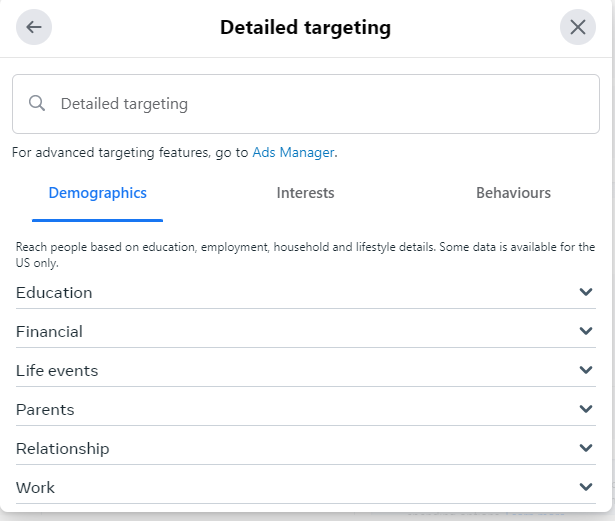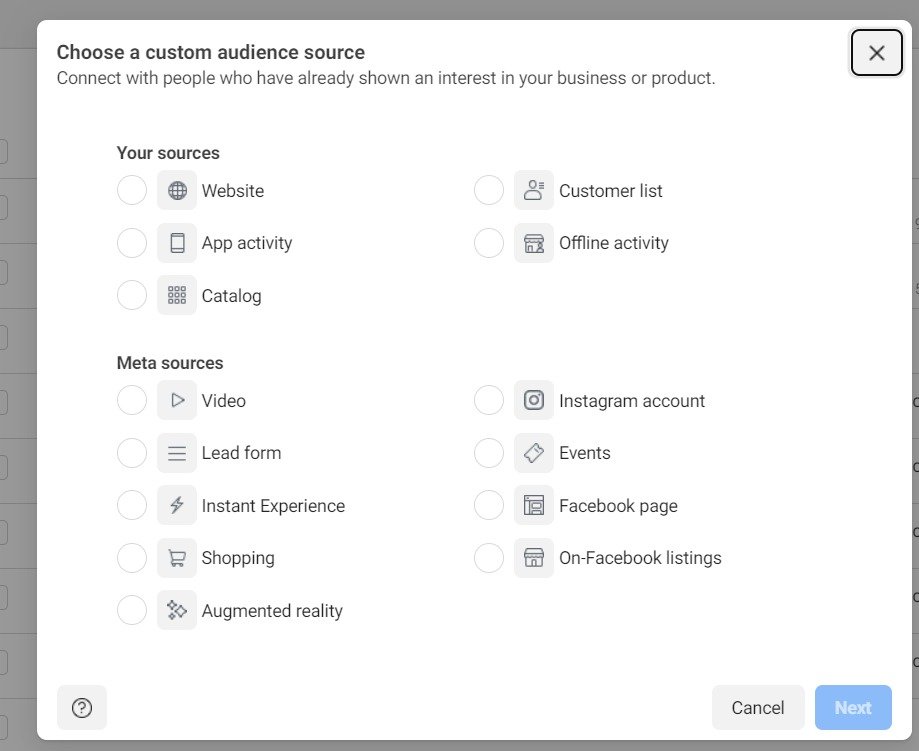Understanding how Facebook’s custom audience works for you: Unlock the power of Facebook Custom Audience with our comprehensive guide. Learn how to harness the full potential of targeted advertising by understanding the intricacies of Facebook’s custom audience feature.
What Is a Facebook Custom Audience?
 Facebook Custom Audiences: Get Extremely Specific with Your Ads: Facebook advertising has completely changed how companies connect with their target markets. With more than 2.8 billion active users each month, the platform provides marketers with an unmatched opportunity to engage with the target audiences. Facebook Custom Audiences stands out among the many tools offered as a key component of successful ad targeting methods.
Facebook Custom Audiences: Get Extremely Specific with Your Ads: Facebook advertising has completely changed how companies connect with their target markets. With more than 2.8 billion active users each month, the platform provides marketers with an unmatched opportunity to engage with the target audiences. Facebook Custom Audiences stands out among the many tools offered as a key component of successful ad targeting methods.
They are specifically targeted populations that have already had some sort of interaction with your brand, which increases the likelihood that they will be open to your advertising.
- Synopsis of Facebook Custom Audiences in Brief: Basically, Facebook Custom Audiences let marketers target certain user groups according to defined standards. These requirements may comprise information from the advertiser’s current client base, internet traffic, app usage, or Facebook participation. By taking advantage of this capability, marketers can customize their advertisements to appeal to audiences that have already expressed interest in their company, goods, or services.
- Facebook Advertising’s Need for Custom Audiences: It is impossible to overestimate the importance of Custom Audiences in Facebook advertising. Custom Audiences allow advertisers to target consumers more precisely than Saved Audiences, which are demographic categories that are manually selected. By targeting individuals who have already interacted with their brand in some capacity, advertisers can increase the likelihood of conversions and maximize their return on ad spend (ROAS).
Why Your Secret Is a Custom Audience Weapon
The days of ineffective, broadly shared ads on Facebook are outdated. Plenty of advantages become available with Custom Audiences:
Optimize your ad expenditure by reaching out to users who are truly interested in your product or service through sharpened targeting, which will increase conversion rates.
Re-engage with former website visitors, app users, or even individuals who have interacted with the information on your Facebook page. Bring them back into the system and spark their curiosity.
Customized Messaging: Write highly relevant advertising content that appeals to the unique requirements and interests of your target audience segment.
Lookalike Audiences (Bonus): Acquire the capability to focus on new people who exhibit comparable traits to your current, valuable clientele. highlighting the Comparisons Between Saved Audiences and Custom Audiences
It’s critical to make clear the differences between Saved Audiences and Custom Audiences. Custom Audiences use user-specific data to improve targeting, while Saved Audiences let marketers create target groups based on variables like age, geography, and hobbies. Custom Audiences allow advertisers to target people who have previously shown a strong interest in their brand, as opposed to reaching a broad audience. This leads to more successful ad campaigns and increased conversion rates.
In a nutshell, Facebook Custom Audiences enable marketers to reach very specific audience segments with tailored messages that promote interaction, lead to conversions, and eventually boost sales.
A Key Difference Between Custom Audiences and Saved Audiences
It’s critical to distinguish between Saved Audiences and Custom Audiences:
Custom Audiences are created by utilizing information from your email list, website, app, and Facebook activities. Since they are dynamic, they may alter if new users satisfy your requirements.
Saved audiences are generated through using demographic data, interests, and actions on Facebook. Since these audiences are static, manual modifications are required.

Improving Understanding of Facebook Custom Audiences
Facebook Custom Audiences are a fundamental component of the platform’s focused advertising strategy, enabling marketers to target particular user groups with customized messaging. We’ll go over the definition, use, kinds, and workings of Custom Audiences in this part to give you an extensive understanding of this powerful advertising tool.
- Purpose and Objective: Facebook Custom Audiences are exactly what their name implies: user-defined groups that advertisers have developed specifically to target with their advertisements on Facebook. Delivering highly tailored content to people who are most likely to interact with it is the main goal of Custom Audiences.
- Different Custom Audience Types: Facebook has many Custom Audience forms, each suited to distinct user data sources and phases of the customer experience. Some of them are:
- Customer Lists: To develop Custom Audiences, advertisers may upload lists of contact details from their customers, such as phone numbers or email addresses. This allows them to convey relevant advertisements and promotions to their current clients or subscribers.
- Traffic to Websites: Advertisers may monitor user behaviors and build Custom Audiences based on website traffic by utilizing the Facebook Pixel, which is a piece of code that is posted on a website. This makes it possible to retarget visitors who have viewed particular sites or completed particular online activities.
- App Activity: Based on user engagements inside the app, Custom Audiences may be developed for organizations that have mobile apps. Users who have completed particular tasks, including making in-app purchases or finishing a game’s level, might be targeted by advertisers.
- Facebook engagement: Facebook user engagement metrics, such as likes, comments, shares, and video views, may also be used to create Custom Audiences. This enables platform marketers to retarget consumers who have engaged with their page or content.
- Mechanisms of Custom Audiences: Custom Audiences function by comparing Facebook user profiles with the data supplied by marketers. Here’s a quick rundown of how it functions:
Data Sources:
- Customer List: Advertisers provide contact details, including phone numbers and email addresses, to Facebook on representation of their customers.
- Website Traffic: Facebb ook receives data from the Facebook Pixel on how users engage with the advertiser’s website.
- App Activity: Facebook receives information about user activities within the advertiser’s mobile app.
- Facebook interaction: Facebook gathers analytics related to user interaction, likes, comments, and views of videos.
Facebook creates Custom Audiences by matching the data with user profiles once it is received. Personalized content may be sent to people who are most likely to interact with it by advertisers through the creation of ad campaigns that are especially targeted at these Custom Audiences.
If marketers want to get the most out of their Facebook ad campaigns, they must comprehend the workings of Custom Audiences and the several kinds that are accessible. We’ll look at how to build Custom Audiences and offer some useful examples of how to use them in actual advertising situations in the next section. Now let’s get started!
Understanding Facebook Custom Audiences
Meaning and Objective: Facebook Custom Audiences are niche audiences that you build according to previous interactions that they have had with your brand. This might be anything from going to your website to seeing your Facebook videos. The main advantage? Compared to a broader audience, these consumers are far more likely to be interested in the advertisements since they are already connected to your company.
Various Custom Audience Types: Facebook provides many methods for creating personalized audiences using various data sources:
-
- Lists of customers: To establish a Custom Audience, upload the phone numbers and email addresses of your current clients. With exclusive deals or the introduction of new products, this is an excellent method to re-engage previous consumers.
-
- Website Traffic: To monitor website visits, use the Facebook Pixel, a tiny piece of code that is added to your website. This enables you to create Custom Audiences according to particular behaviors on the internet. Retarget visitors who, for instance, saw a certain product page, abandoned their carts, or spent a particular amount of time on your website.
-
- App Activity: Custom Audiences may be made based on user behavior within your mobile app, if you have one. This enables you to target users who have accomplished particular tasks, such as finishing a game level or making an in-app purchase.
-
- Facebook engagement: Create audiences by analyzing user interactions with your Facebook page.
How to Set Up a Custom Audience on Facebook
- Identify Who Your Target Market Is: Make sure you know exactly who you want to target first. Think about demographics like location, age, gender, hobbies, and behaviors. The more precise you can be, the more effectively you can target your advertisements to appeal to your target market.
- Open the Facebook Ads Manager: Go to Facebook Ads Manager to get the resources you need to design and oversee your advertising campaigns. Locate the “Audiences” option to begin creating a personalized audience.
- Select Your Source of Data: Facebook lets you build custom audiences with a range of data sources, such as:
- Customer Lists: Provide a list of your current clients’ phone numbers, email addresses, and Facebook user IDs.
- Installing the Facebook Pixel on your website will allow you to track visitors and build customized audiences depending on the things they engage with.
- App Activity: You can build unique audiences of users who have completed particular actions within your mobile app if you have one.
- Interaction: Focus on those who have interacted with your Facebook page, videos, lead forms, or gatherings.
- Focus on Your Audience: After selecting your data source, you may use Facebook’s additional targeting choices to further narrow down your audience. Demographics, hobbies, habits, and even life events are among them. Use these options to focus on a more specific demographic and make sure your advertisements are really suitable.
- Develop Your Marketing Initiative: It’s time to draft your advertising campaign after you’ve defined and refined your unique audience. Whether your aim is to increase conversions, generate leads, or increase visitors to your website, pick the one that best fits your marketing objectives. Create a compelling advertisement, then allocate funds and time appropriately.

Facebook Custom Audience’s advantages

- Targeting using Laser Focus: By specifically targeting particular audience segments with Facebook custom audiences, you can make sure that the individuals who are most likely to be interested in your products or services see your ads.
- Budget-Friendly Promotion: You may optimize your ad expenditure by addressing a highly focused audience and reducing the amount of money you waste on unnecessary clicks or impressions.
- Higher Conversions and Engagement: Delivering tailored communications that connect your audience with custom audiences may increase engagement rates and, eventually, conversions.
- Possibilities for Remarketing: You can retarget individuals who previously engaged with your brand, such as website visitors or previous customers, using Facebook custom audiences. This will help you stay in front of their thoughts and boost repeat business.
Put it up, Facebook custom audiences are revolutionary for advertisers hoping to get the most out of their campaigns on the biggest social media network in the world. You may improve outcomes and accomplish your marketing goals by knowing your audience, making use of Facebook’s extensive targeting tools, and creating engaging ad campaigns.
- First Example: Presenting a New Good or Service to Current Customers Situation: Let’s say a retail business wants to target its current customer base when introducing a new range of items.
- Example 2: Displaying Relevant Ads to Website Visitors Scenario: Let’s say an online retailer want to reach out to customers who left their carts empty.
- Example 3: unique Promotions to Engage App Users: Imagine a mobile app that wishes to offer its users unique promotions based on their past interactions.
- Case Study 1: Custom Audiences Helped Company X Run a Successful Campaign Scenario: Let’s examine how Company X used specialized audiences to their advantage in their marketing effort, yielding outstanding outcomes.
Scenario 1: Retargeting Website Visitors:
An online retailer follows up with customers who left their carts empty. Developing a Particular Audience: You may use Facebook Pixel to follow users who leave their shopping carts empty and use the information to build a personalized audience.
Ad Copy: “Make sure you don’t let your shopping splurge end! Finish your order right away to receive a great discount on your preferred products. Temporary promotion!”
Scenario 2: Reaching Out to Former Clients
For instance, a restaurant can make a special deal to entice former customers. Building a bespoke Audience: Enter the phone numbers or email addresses of previous clients to create a bespoke audience.
Copy for the Ad: “We miss seeing your happy smiles! Enjoy a complimentary appetizer with your entrée when you return to dine with us. Reserve a table right now!”
Scenario 3: Facebook Engagement Rekindles Interest
For instance, a fitness center targets clients who have already seen their exercise videos. Developing a Particular Audience: Make a personalized audience out of those who liked your Facebook exercise videos.
Advertisement Copy: “Are you prepared to advance in your fitness quest? Attend a complimentary trial class with us to feel your enthusiasm and energy for yourself. Make your reservation right now!”
Advanced Techniques for Particular Audiences
- Lookalike Audiences: Described and Utilized: Lookalike audiences are user groups that resemble your target demographic or current clientele in comparable ways.
How to Use Them: You’ll need a source audience, either one of your current clients or a custom crowd you’ve already built, in order to establish a Lookalike audience. Facebook then seeks others who have these characteristics but might not be in your current audience by identifying common attributes among these individuals. When it comes to reaching new, highly relevant individuals who are probably interested in your goods or services, lookalike audiences may be quite effective.
- Custom Audience Segmentation for Improved Targeting Definition: Custom audience segmentation is breaking up your audience into more manageable, focused groups according to predetermined standards like engagement level, interests, behaviors, or demographics.
How to Apply Them: Your chances of engagement and conversion will rise if you segment your bespoke audience and provide each group with more individualized messaging and offers. Make use of Facebook’s segmentation tools to customize your adverts to each target segment’s particular requirements and preferences.
- Custom Audiences Defining Dynamic advertisements: Dynamic advertisements present customers with the most relevant goods or services based on their previous interactions with your app or website.
How to Apply Them: You may give your audience highly customized and timely content by using bespoke audiences in combination with dynamic advertisements. You may retarget a user who visited a certain product page on your website but left without purchasing it, for instance, by showing them an advertisement for that precise product combined with a special discount to encourage them to finish the transaction.




